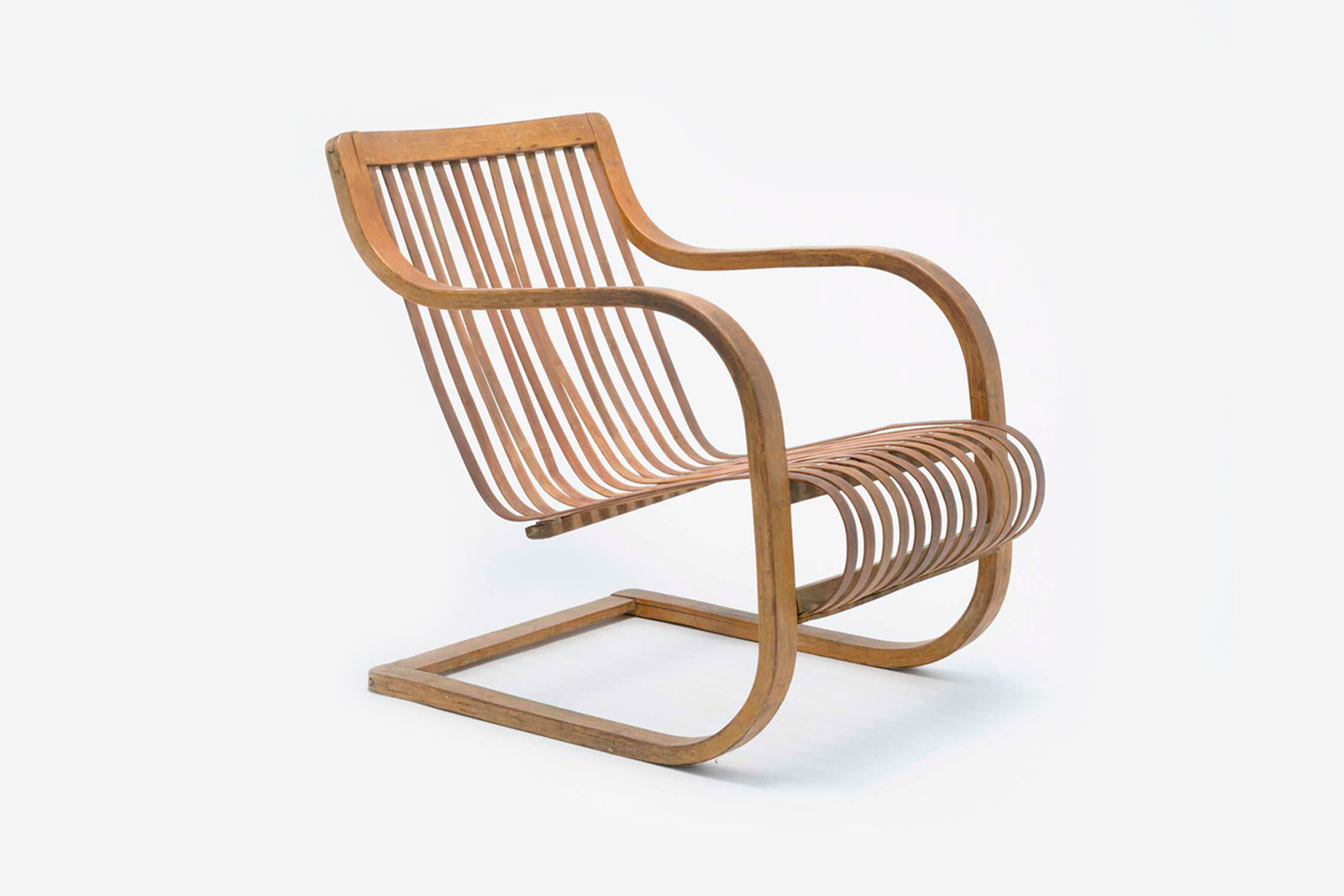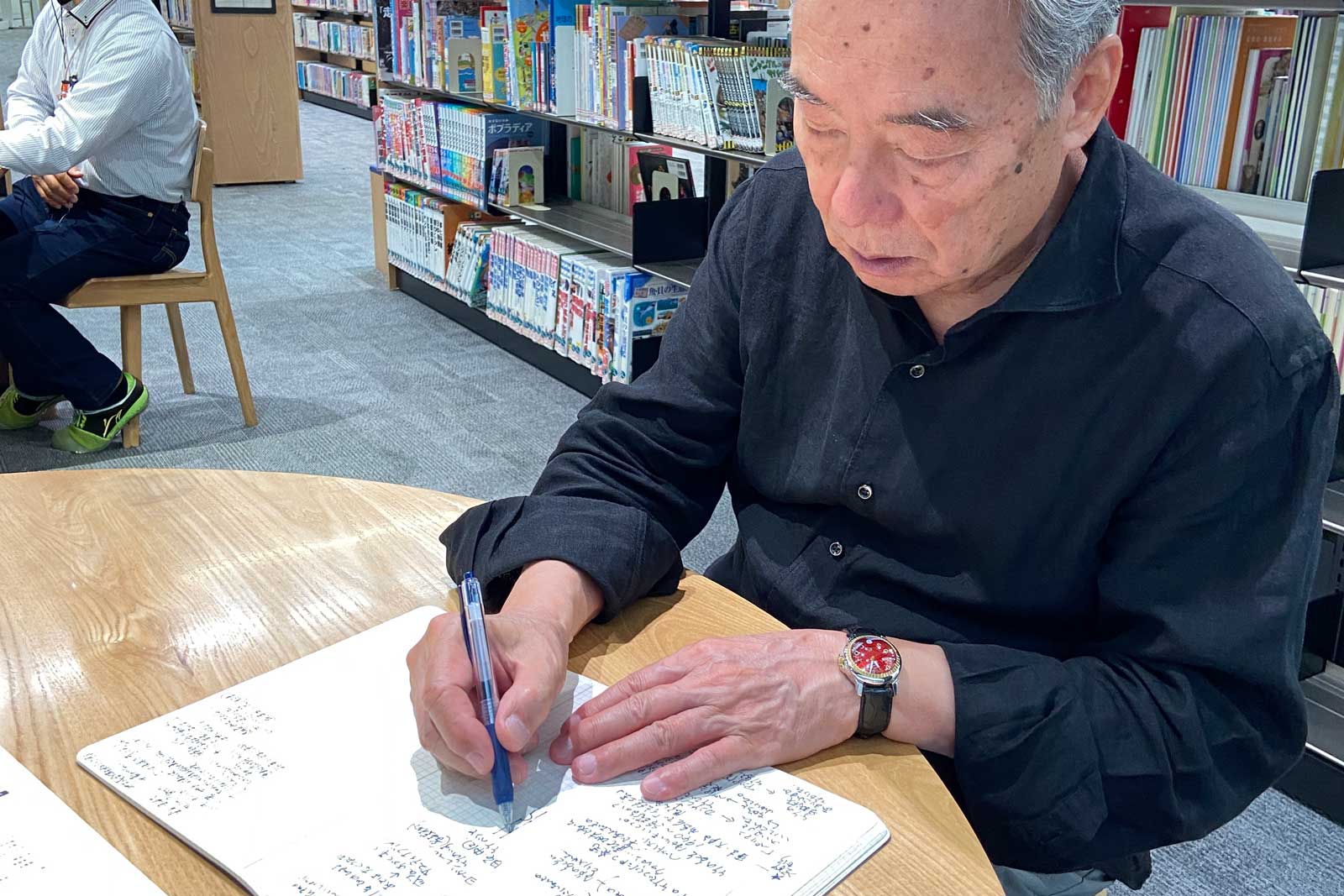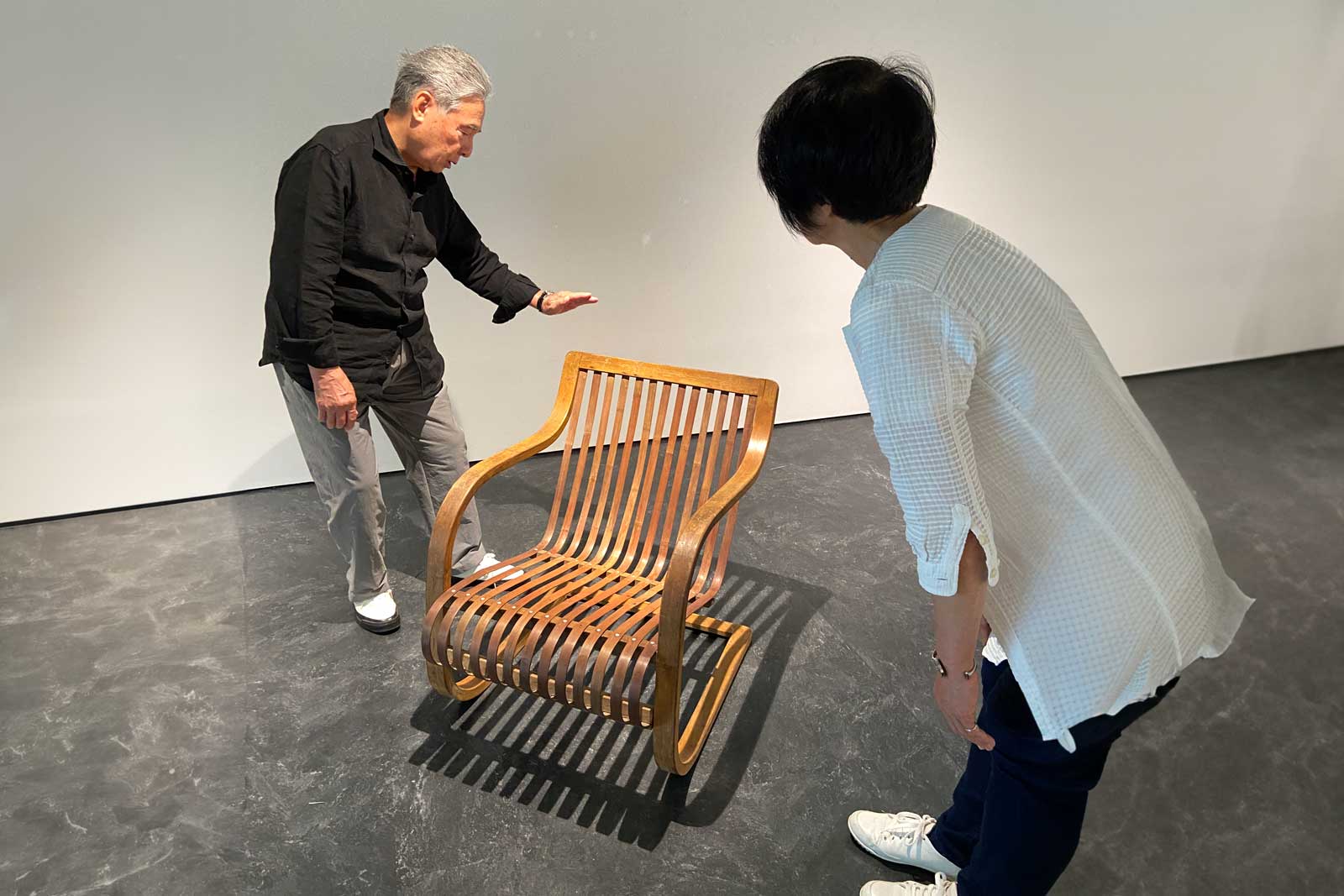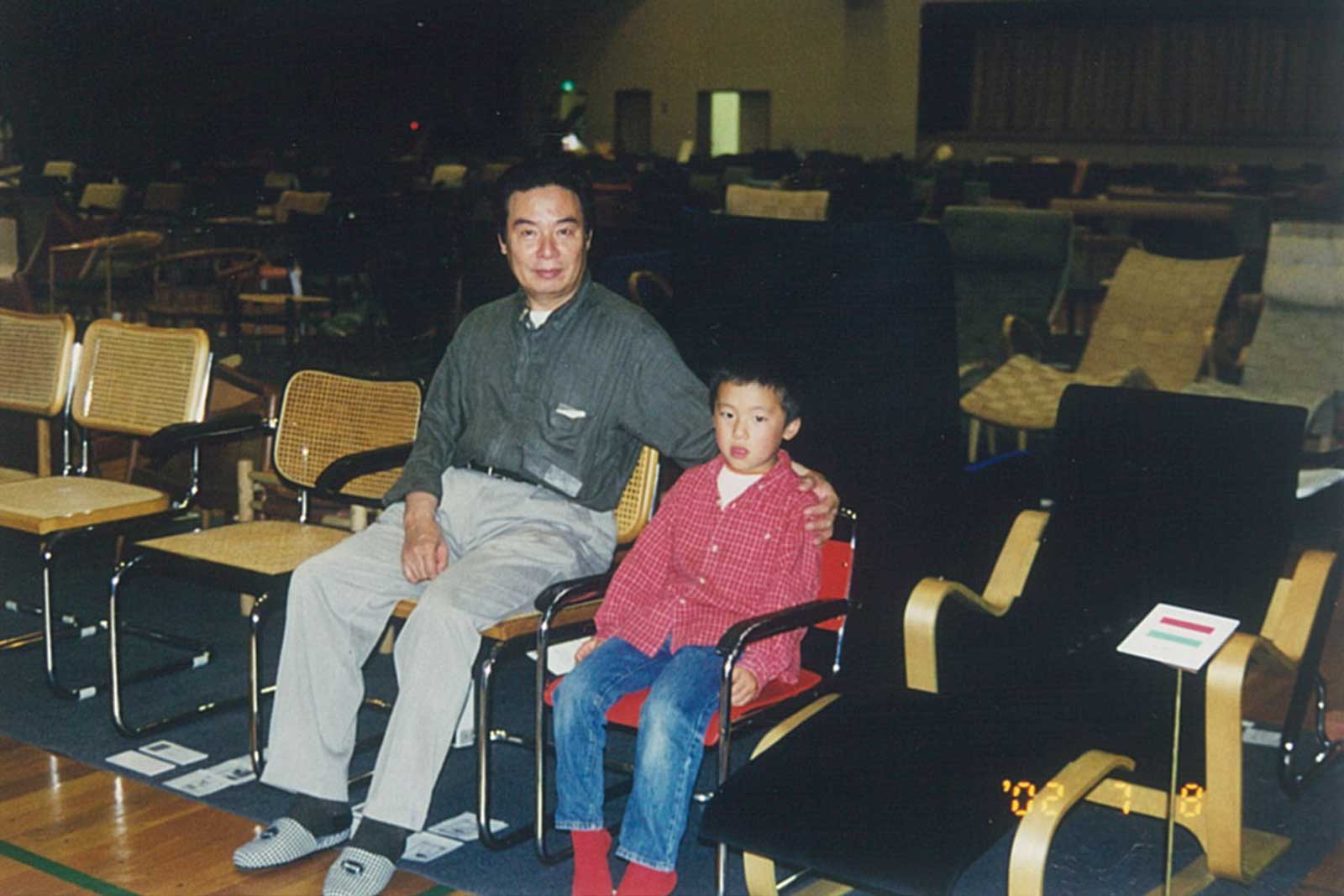
Bamboo Chair (1937)
A chair with a cantilever structure (cantilever, protruding) that utilizes the elasticity of bamboo. Long and thin strips of bamboo are arranged vertically from the back to the seat and fasted to the crosspieces on the back of the seat with rivets. The frame is also made of bamboo, and it is an eight-ply lamella-bent material (all piled up and bent in the same direction), which had never existed before. Some bamboo cantilevers were also made overseas.
A friend invited me to meet a man and
the man I visited who he was a “Forest King”.
I visited him for the first time in 1994, shortly after I came to Asahikawa alone, and I think it was around the following year. There was Mr. S’s house in the town next to Asahikawa. When you enter the tree-lined road from the national highway, a wide tree-lined road with large trees on both sides continues for about 200m. I was surprised to hear later that this tree-lined street was also Mr. S’s property. Mr. S’s deceased father was a large landowner in the area, and his house had three ponds and he had a house for servant. When we visited, Mr. S was living in the house that the servant was using, but it was a very large house that I couldn’t believe it was for the servant’s house. The main building had already been demolished, but it is said that members of the imperial family stayed there, so there is no doubt that it was a mansion. By the way, Mr. S had graduated from the University of Tokyo, and it seemed that he stayed at the Imperial Hotel for four years while he was in school and went to school from there. There are wild people in the world.
When I visited for the second time,
I found a bamboo chair.
Well, the episode starts from here. I visited Mr. S’s house again after that. When I contacted him, he was in good health despite his age, and was shown to his room and treated to coffee. Not only was the interior spacious, but it was also an advanced design for the time when ondol (underfloor heating seen in Korea and elsewhere) was incorporated. By chance, when I looked at the porch, I saw Ubunji Kidokoro’s “Bamboo Chair”. Moreover, two legs were lined up in a beautiful state. Actually, I already had one of these bamboo chairs at that time. Around 1990, when the collection exceeded 800, it was a gift from Ryuichi Nakamura, a professor at Kyoto City University of Arts and although I knew of its existence, it was the first time I had seen it in person. When I found the same chair at Mr. S’s house, I was really surprised to find it in this small town in Hokkaido. Of course, I wanted to say I wanted that chair, but I couldn’t say it and left.
May 2023,
I got a call from Mr. S’s daughter.
And this spring, I got a call from Mr. S’s daughter who lives in Tokyo. She said, “After my father passed away, local people helped me cut the grass and took care of the inside of the house, but the damage to the building was so bad that I decided to demolish it. I heard you’ve seen our house before and there were two bamboo chairs. Could you take the two bamboo chairs that were there at that time?”. I immediately asked to see the house again. As I heard, it was crumbling everywhere and was in a dangerous state. The bamboo chair was still on the porch, and a small table was visible between the two chairs. Since the legs are made of laminated bamboo, which is exactly the same as the chair, it is probably a set. The top plate is covered with decora and the sides are made of aluminum. It may be around 1955. It is also possible that Ubunji designed it later. In any case, it was a precious thing that I had never seen before, so I was allowed to take it in together.

As for the bamboo cantilever,
Kidokoro was ahead of Perian.
The cantilever structure was invented by Mart Stam of Bauhaus and spread, and architects and designers around the world worked on many chairs. French architect Charlotte Perriand was invited by the Ministry of Commerce and Industry, and she stayed in Japan for two years from August 1940 as a design and a craft instructor. At that time, the architect Junzo Sakakura, who studied at Le Corbusier’s atelier, and Sori Yanagi, a central figure in the Mingei movement, were in charge of guiding us. Perriand was surprised by the Japanese craftsmanship sites and the spirituality that lives there, and felt deeply something that Europe did not have. Perriand then began incorporating straw and grass into his furniture designs, and designed a bamboo version of Corbusier’s LC4, introduced in the first episode of this series. From the time he came to Japan until the end of the war, he seemed to have released several pieces of bamboo furniture. He also designed a chair very similar to this bamboo chair, and many people think that Kidokoro was inspired by that work, but in fact, it was Kidokoro who announced it first. Kidokoro Ubunji was an engineer at the Mitsukoshi Department Store’s Decoration Department (now the Construction Department). At that time, department stores were mainly engaged in the interior design of large passenger ships, while also producing original furniture that they designed independently. The Bamboo chair is probably a reference to the cantilever model introduced by Alver Aalto in 1932.

In the collection,
there are about 30 to 40 Chairs of Japan.
The standard of the collection is “things that I think should be left”, even for things of Japan. Among them are some valuable prototypes of Asahikawa furniture, but there are not many chairs of Japan. Japanese houses, where floor seating is the basic lifestyle, have ceilings of 2400 feet, so many legless chairs and low legless chairs that do not feel oppressive have been created.
I think that Japanese furniture needs to improve its design skills more and more. As for Asahikawa furniture, more and more manufactures are actively participating in joint development, but it is important to partner with excellent domestic and foreign designers and continue joint development, even if it means paying royalties. If executive can hone their intellect and sensibilities and build equal relationships with designers, collaboration will continue to expand. The same goes for craftsmen. Designers and engineers must be placed in a higher position than they are now so that they can speak on an equal footing. If this is reflected in the compensation, the treatment will be better and the quality of work will also improve. According to Kasper Pedersen, president of PP Mobler, who gave a lecture in Higashikawa the other day, all workers at the company are paid 6,000 yen per hour, regardless of age or gender.
In fact, the grandfather of the Oda family was also a researcher.
This is an aside, but the botanist Tomitaro Makino, who has become a hot topic in dramas, is from my hometown, Sagawa-cho, Takaoka-gun, Kochi Prefecture. And my grandfather was a researcher who collected plants with Tomitaro Makino where he was young. I heard that the Oda family was also involved in managing the mountains and land, and compiling the history of the town. Mr. Yokokura (also known as Utaki or Omitake-san), where Tomitaro Makino is said to have discovered a new species of Yokoguranoki, has an altitude of about 980m and a very beautiful shape. It is a familiar mountain that I climbed more than 30 times from my childhood to high school. The Oda family were descendants of Heike fugitives, and lived in a village called “Kusunokami” in Yokokurayama. My father was also born there. The Oda family has taken over the priesthood of Yokokura Shrine in Yokokurayama for generations, and my father was also a priest. Originally, I should have become a Shinto priest myself, but since I moved to Osaka for college, my relatives took over. But I inherited my gradnfather’s DNA as a researcher, so place accept that (laughs).
July 12th, 2023 Centpure (Higashikawa)
Interviewer: Kano Nishikawa
[ After the interview ]
This time, the interview started at 10:00 in the morning, and when we finished, it was just around lunch time (laughs). Mr. Oda said, “Let’s go to lunch” and took me to a nearby popular restaurant, “Chiba Shokudo.” While I was eating sable fish meal, I told Mr. Oda that my second son, who came with me to the “1000 CHAIRS exhibition” of the Oda collection held in the gymnasium of the Hokkaido Tokai University Asahikawa campus in 2002 , had a wedding last month. The photo is from the gymnasium at the time, and I happen to be sitting in the child chair by Marthe Stam, the inventor of the cantilever structure chair, which I took up this time. This kid is 27 years old. The number of Oda collections and my years with Mr. Oda should increase (laughs) That also should be expected.


Copywriter Kano Nishikawa
After working at a design office in Tokyo and Sapporo, I started working as a freelancer in Asahikawa in 2001. Until now, I have been involved in the production of advertisements for local companies and organizations, including Asahikawa Furniture. I have known Mr. Oda for about 30 years through my work.

